#Lin Huiyin
Photo
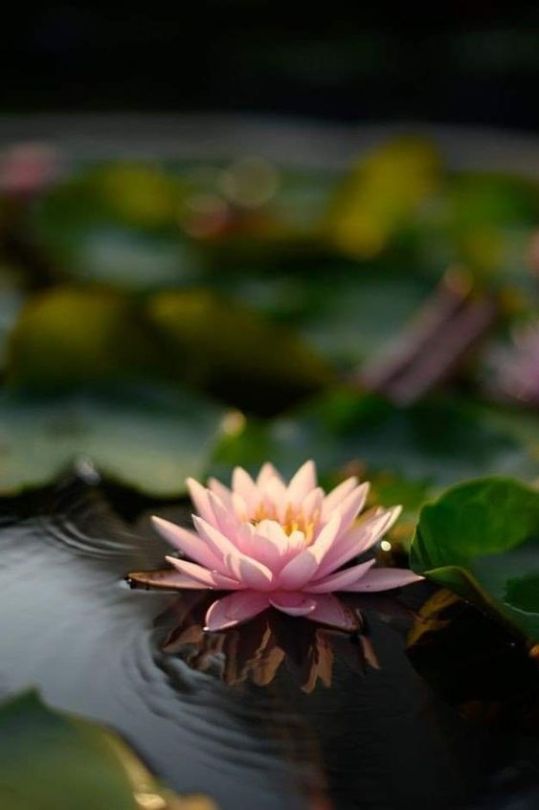
Se il mio cuore è un fiore di loto
con una candela accesa nel mezzo allora,
anche se è luce di taglio, voglio che mostri orgoglioso la sua gloria.
Lin Huiyin, Sogni sotto la lampada di loto
29 notes
·
View notes
Text
Lin Huiyin từng nói rằng: "Tôi không bao giờ tin rằng một người chỉ có thể yêu một người trong đời, nhưng tôi tin rằng sẽ luôn có một khoảng thời gian bạn sẽ gặp được người mà bạn muốn yêu cả đời. Điều hối tiếc lớn nhất trong cuộc đời không phải là bạn đã bỏ lỡ người tốt nhất mà là bạn đã bỏ lỡ người muốn đối tốt với bạn nhất. Bởi vì chúng ta chỉ đi ngang qua nên lãng quên chính là kỷ niệm đẹp nhất mà chúng ta dành cho nhau, người ta yêu hay người ta không yêu đều luôn nói lời từ biệt"
@taifang dịch

34 notes
·
View notes
Text
[Chinese poetry tag] 你是人间四月天 You are the April of this world - 林徽因 Lin Huiyin

Today we will be exploring a poem by one of my favourite historical figures and role models, 林徽因 Lin Huiyin. Born in 1904, Lin Huiyin was a renowned architect, historian, poet and intellectual who played a huge part in the restoration of Chinese cultural heritage sites and the design of the national emblem of the P.R.C.
I know many poems by her off by heart - she’s one of the few people who has successfully managed to fuse together the structures and tempo of English poetry and prose, with the ambiguous and emotive vocabulary of the Chinese language.
This is exactly what her close friends loved about her – Wilma and John K Fairbanks admired her for living on a “kind of double cultural frontier,” and facing the problem of “the necessity to winnow the past and discriminate among things foreign, what to preserve and what to borrow.”
She is probably best known for this poem below, called “You are the April of this world”, written in 1934. It is widely interpreted that the poem was written to either commemorate the death of 徐志摩 Xu Zhimo, another Chinese poet whom she had a whirlwind romance with in the UK, or the birth of her son (latter more likely from my perspective).
你是人间四月天
我说 你是人间的四月天;
笑响点亮了四面风;
轻灵在春的光艳中交舞着变。
你是四月早天里的云烟,
黄昏吹着风的软,星子在
无意中闪,细雨点洒在花前。
那轻,那娉婷,你是,
鲜妍百花的冠冕你戴着,
你是天真,庄严,
你是夜夜的月圆。
雪化后那片鹅黄,你像;
新鲜初放芽的绿,你是;
柔嫩喜悦,水光浮动着你梦期待中白莲。
你是一树一树的花开,
是燕在梁间呢喃,
——你是爱,是暖,
是希望,
你是人间的四月天!
Translations (by me)
You are the April of this world
I say, you are the April of this world;
Your laughter ignites the winds hither and thither;
Tinkling and dancing to the brilliant lights of spring.
You are the soft haze of April mornings,
Dusk blows the mellowness of the breeze,
The stars glittering subconsciously, fine rain drops sprinkle like wine amid the flowers.
That gentleness, gracefulness, is you,
It is you wearing a radiant crown of a hundred flowers,
You are innocence, dignity,
You are the full moon night after night.
Ivory swathes after melted snow, is like you;
New shoots of verdant green, is you;
Tender joy, the sparkling ripples carry long awaited white lotuses of your dreams.
You are the trees that bloom,
The swallows that chitter between the roof beams,
—— you are love, warmth,
Hope,
You are the April of this world!

#Chinese poetry#Chinese literature#poetry#prose#Lin Huiyin#role models#female pioneers#female writers#female poets#love poem#林徽因#Chinese culture#reading#Chinese tag#Chinese poetry tag
100 notes
·
View notes
Photo
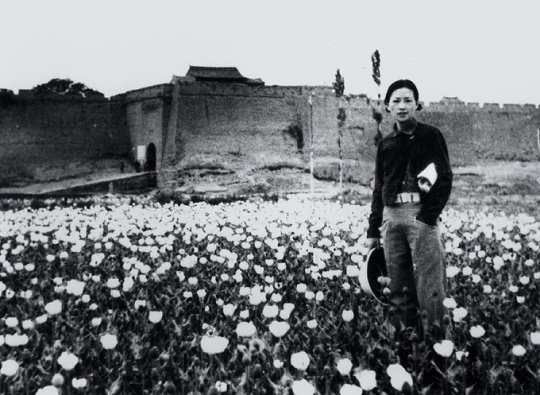
Lin Huiyin (林徽因). Quiero aprender chino para leer todos sus ensayos y poemas.
7 notes
·
View notes
Text
"人间四月天"
(you are the april day of the world)
-Lin Huiyin
16 notes
·
View notes
Photo

Lin Huiyin (1904-1955) was the first female architect in modern China. She was involved in the restoration of numerous heritage sites in the country.
She studied in the United Kingdom and United States, and helped established the Architectural Department of the Northeastern University in Shenyang upon her return. She also participated in the design of the Chinese national flag and emblem.
#born on this day#amazing women#lin huiyin#china#architecture#women in architecture#women in history#feminist#feminism
382 notes
·
View notes
Photo

L'inverno ha una sua ragione
il freddo è come un fiore -
un fiore ha il suo profumo, l'inverno un pugno di ricordi.
L'ombra di un ramo secco, come un esile fumo azzurro,
dipinge una sola pennellata sulla finestra del pomeriggio.
Al freddo, la luce del sole diventa pallida e lentamente si inclina.
E così
bevo il mio tè in silenzio
come in attesa che un ospite parli.
1936
Lin Huiyin, Seduta in silenzio, da The collected poems of Lin Huiyin, 1985
27 notes
·
View notes
Text
The Day After Rain by Lin Huiyin
I love the day after rain
And the green grasses on the meadow!
My heart is endlessly blowing with wind,
Blowing with wind:
Away the sweet grasses and fallen leaves,
Away the clouds like smoke
Like smoke.
4 notes
·
View notes
Photo
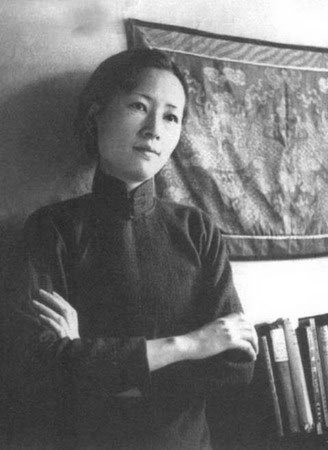
林徽因 Lin Huiyin (Hangzhou 1904, Beijing 1955)
11 notes
·
View notes
Quote
那时大概刚是午后两点钟光景,一张刚开过饭的八仙桌,异常寂寞地立在当中。桌下一片由厅口处射进来的阳光,泄泄融融地倒在那里。一个绝对悄寂的周围伴着这一片无声的金色的晶莹。
It was approximately two o'clock in the afternoon. A large table that had just been cleared of the previous meal's plates was standing solemnly in the hall. A patch of sunlight had made its way onto the ground underneath the table, where it lay poured out and dispersed on the floor. The silent patch of glittering gold was shrouded in an environment of absolute quiet.
“A Patch of Sunlight” (一片阳光) by Lin Huiyin (林徽因), translated by Jiaqi Kang.
A notable figure in the advancement of women in 20th century Chinese society, Lin Huiyin was considered the first female architect in modern China and a renowned writer. She and her scholar-architect husband, Liang Sicheng, were the founders of the Architecture Department at Northeastern University and later worked as professors at Tsinghua University (清华大学).
Throughout her life, Lin was dedicated to the preservation of Chinese architectural and cultural history, commemorating heritage sites through writing and lobbying for the protection of ancient edifices. She was romantically pursued by the poet Xu Zhimo, with whom she became lifelong, albeit distant, friends. Lin chose to wed Liang because Xu had already had a wife and she was unwilling to stand in the shadow of another marriage.
In addition to extensive involvement in architecture and activism, Lin was a prolific and well-received writer. She wrote poems, short stories, essays, and plays that were praised for their creativity and depth of thought. Years after her death in 1955 from tuberculosis, Lin’s legacy is being revived, and her substantial influence on the artists in her community. Lin is the aunt of Maya Lin, a renowned designer and architectural artist previously featured by sinθ.
#lin huiyin#phyllis lin#architecture#chinese architecture#liang sicheng#xu zhimo#chinese art#chinese writing#northeastern university#tsinghua university#week 23#ec
40 notes
·
View notes
Quote
Now the moment flows away like water,
swiftly, quietly,
like the distant cold of a mountain spring,
bubbling in a grove of pines at night –
vague as a sigh.
Lin Huiyin (林徽因), from “Do Not Forget”, The Flowering of Modern Chinese Poetry: An Anthology of Verse from the Republican Period, tr. Herbert Batt and Sheldon Zitner
#poetry quotes#lin huiyin#chinese poetry#林徽因#20th century poetry#herbert batt#do not forget#quotes#sheldon zitner
22 notes
·
View notes
Note
have you seen this video @fuckyeahchinesefashion posted? /post/663223541535211520/history-of-chinese-school-uniform-by-朵朵花林 i love how all the uniforms look and the changes are so fascinating! i thought you would be especially interested in the early 20th century ones :)
Link to the video
I love the concept of an “evolution of school uniforms” video but unfortunately the uniforms presented are quite stereotypical and incorrect when it comes to construction. I guess this is sort of inevitable with these “one hundred years of” videos :/ I’ll break down each of these looks in some detail.
1910s

This one is taken from a famous photograph of Lin Huiyin and her cousins from 1916 so theoretically not much could go wrong, yet they somehow managed to misunderstand the proportions. The robe/shirt in the photograph is longer than that in the video, and the cut is looser and not as tight. I can’t see it clearly in the video but I think their shirt was taken in at the waist with darts, which was not a thing that happened in the 1910s. In the 1910s, flat chest was still the beauty ideal, so busty women would wear breast binders to flatten their chest. This wasn’t even necessary for schoolgirls who haven’t hit puberty yet, so it would be even more sensible to give them flat shirts. Overall the fit should be more roomy and less skin tight. Apart from that, the standing collar is a bit too loose around her neck.
I’m always made uncomfortable by the text in this kind of posts/videos, they love to connect fashion to the grand narrative about national salvation which people back then didn’t remotely think about when designing new clothes. Most of the cultural meanings attached to Republican era fashion were added after the fact.

Source
Lin Huiyin (far right) and co.
1920s
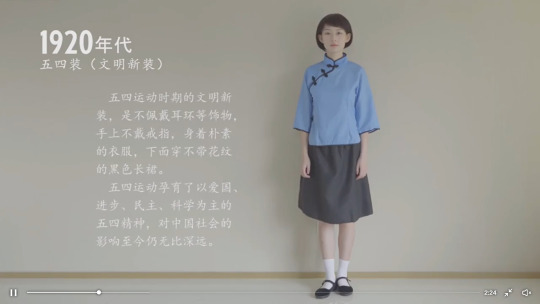
The 1920s one is especially bad because it’s literally a cheap stereotypical “May Fourth uniform” Halloween costume. The construction is not great; the missing neck area binding, the not at all common decorative buttons, the use of darts, the terrible loose fit of the collar, the lack of curve in the 大襟 dajin (front closure) etc., etc.. What I never understood about this costume is the fact that the black binding they always use just accentuates the lack of neck area binding and makes the giant loose collar look like a pimple on an otherwise smooth shirt. The same problem with the waist darts persists, 1920s clothes were still flat at the chest. Also, 1920s school uniforms were not necessarily blue shirt + black skirt, I don’t know where that perception came from. If you look at photographs or drawings from the period you don’t see a lot of plain blue shirts. Black skirts were pretty common, but the late 20s ones that went with the shirt with flared sleeves often had floral trims and were not strictly plain like it says in the text.

Taobao search result for “May Fourth costume”.
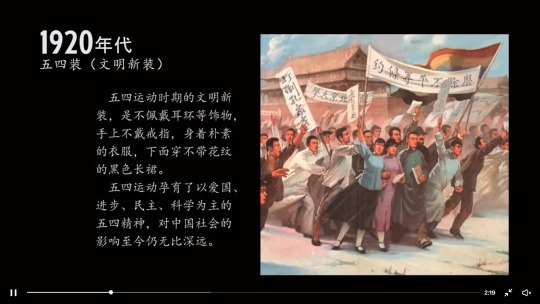
The reference image they showed was the painting 五四运动 “May Fourth Movement” by 周令钊 Zhou Lingzhao from 1951, meaning it wasn’t an original artwork from the 20s and thus not reliable. The art style does not match that of the late 1910s/early 20s, the emphasis on the two women’s breasts was the opposite of the beauty ideal of the 20s, and the inclusion of a woman wearing cheongsam for an image supposed to represent the late 10s/early 20s (this style of cheongsam was popularized ca. 1927) betrays the fact that the artist possessed only very basic knowledge of fashion history. These stereotypical “May Fourth uniform” shirts likely originated in the 50s or 60s, because the use of no neck area binding, the straight instead of angled dajin (which is important but often overlooked), fabric, binding and button choices all resemble 50s Hong Kong style cheongsam more than they do 20s clothing.

Source
Really reminds me of this 50s cheongsam worn by Li Lihua somehow, though this is infinitely better tailored.
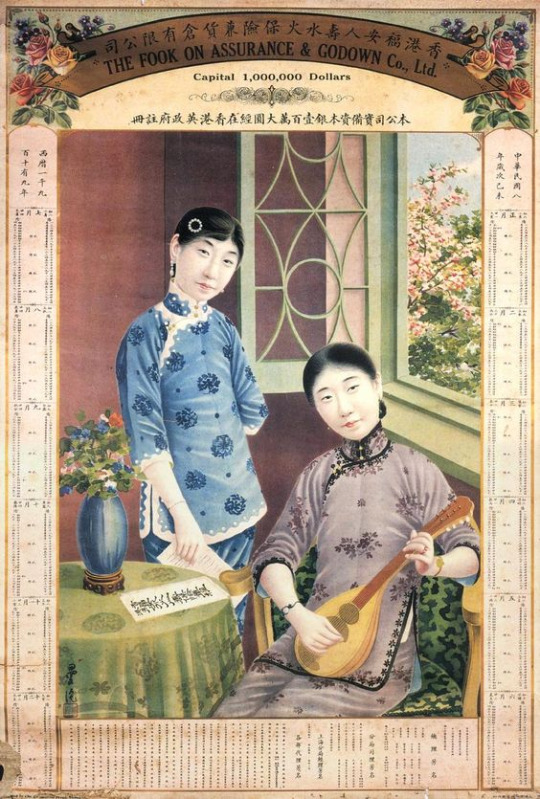
Source
1919 fashion. You can see how flat their chests are.
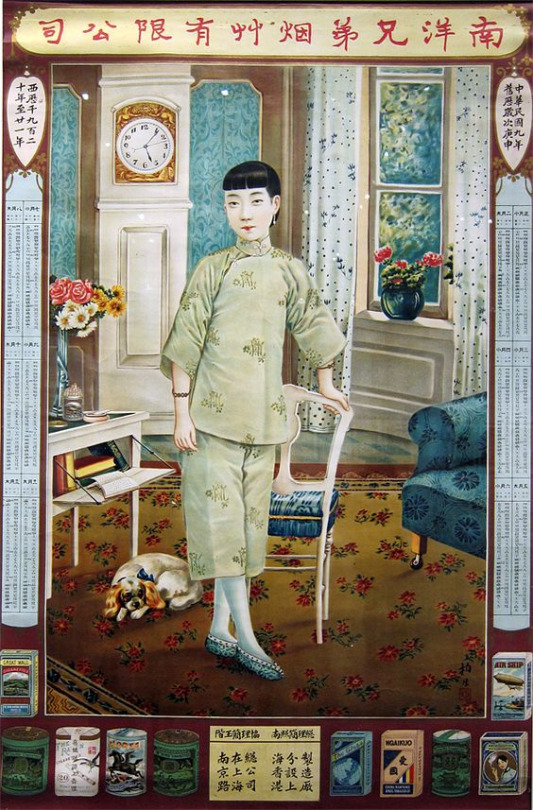
Source
1920 fashion (this is to show you the robe and collar).
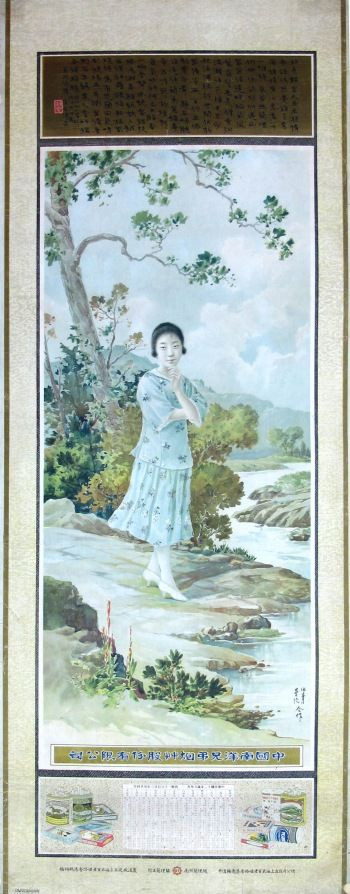
Source
From 1922, this is to show you the skirt.
As to black skirts, they did not become really popular until around 1926. For reference, the May Fourth movement happened in 1919.

Source
Ensemble ca. 1927.
If you insist that the “May Fourth costume” is accurate and looks identical to 20s clothing, maybe, uh, get your eyes checked please.
1930s

The 1930s one is, again, stereotypical and not very well constructed. The blue color is actually appropriate this time because blue Indanthrene fabrics were more popular in this decade. The cheongsam construction, especially the collar construction, is questionable. This is quite a common problem for modern “Republican era style” cheongsam construction: the hole for the collar is too big, resulting in the buttons being closer to your collarbones than the bottom of your neck and the collar appearing lower than it should. This issue is exacerbated by the weird placement of the buttons: two placed at the very bottom and sitting close to each other. This was not done at any time in the 30s, or any time in the Republican era, really. The collar design itself doesn’t look like anything popular in the 30s either, it’s too rectangular and tall to be late 30s, but too low and saggy for early 30s. The sleeve length is very popular among costume designers and Taobao shops but very rare in the 1930s.
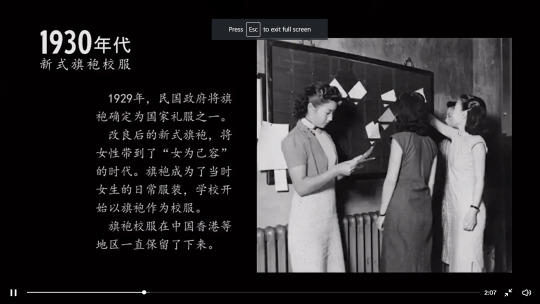
The reference image they used looks like it’s from the 40s, (I love how at the end they named all the reference images except the questionable ones) leading to the incorrect use of a 1940s hairstyle as well. On a tangent here, the text is again slightly cringy, saying something like “the modernized cheongsam brought women into the era of dressing for themselves”. This has two incorrect and problematic implications: 1) that women did not dress for themselves prior to the 1930s 2) women needed to have freedom of dress “delivered” to them through a specific garment, rather than simply a change of mindset.
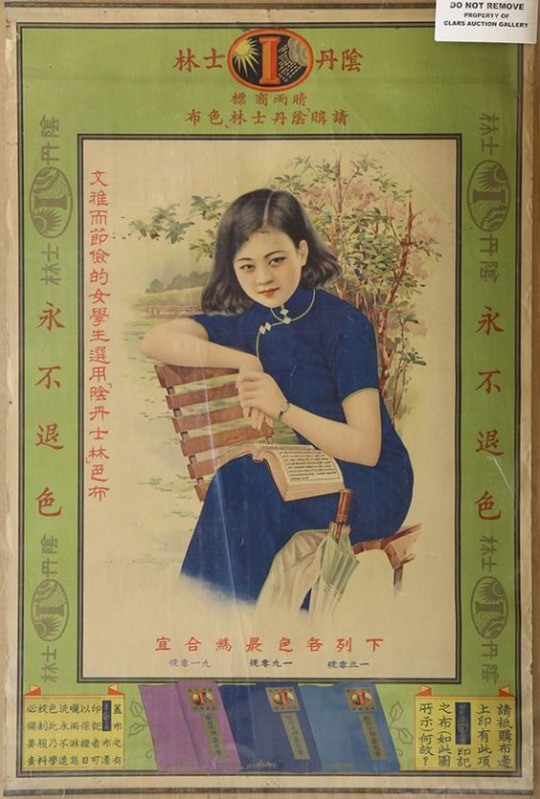
Source
Early 30s Indanthrene cheongsam (Indanthrene came in many shades of blue, purple and red).

Source
1930s students in floor length cheongsam. See how well fitted their collars are!! And they all have either straight bobs or side parted short finger waves, not pinned back brush out curls.
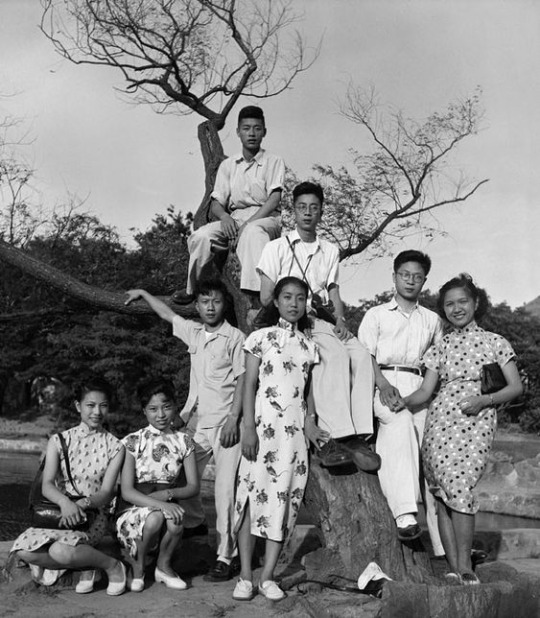
Source
1940s cheongsam, as featured in the reference image.
1940s

This one is fairly ok, though it’s specifically sportswear and probably wouldn’t be worn inside classrooms or for non sports activities.
1950s

This one is a wild ride so brace yourselves. She got the red scarf and braided hair correct, I’ll give her that, but the rest of the outfit... I’ve never seen a single photo of a schoolgirl who dressed like this, let’s just put it this way. The common outfit for urban schoolgirls and students in the 1950s was the combination of a white blouse and a swing skirt/pair of wide legged pants, often with the blouse tucked into the skirt/pants. Pinafores could also be worn instead of skirts. For country girls, aoku outfits were more common (they always have been throughout the 20th century), though they certainly did not look like what is shown in the video. The most common shoes were black mary jane flats with white bobby socks underneath, as well as other Western construction shoes popular in the 1950s. To be fair, children and teenagers’ clothing did not change much from the 1930s to the 1950s at all, they remained cute and frilly Western construction clothes. She should look more like Audrey Hepburn in Roman Holiday than whatever this is supposed to be. The color scheme and fabrics are really a choice...

Source
Artwork from 1963 but the 50s was similar; children’s clothing didn’t change much from the 30s to the 70s. Generally, the younger you are, the shorter your skirt is allowed to be.

Source
1955 poster showing a girl in blouse and pinafore.
In case you’re wondering if these are super romanticized I have some photographs as well:

Source
1956 photograph. This is a group of university students but still, you see the blouse and skirt/pants.
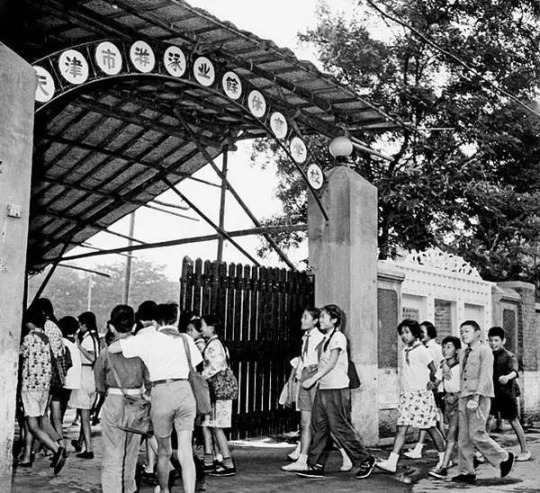
Source
1959, school children heading to the pool.
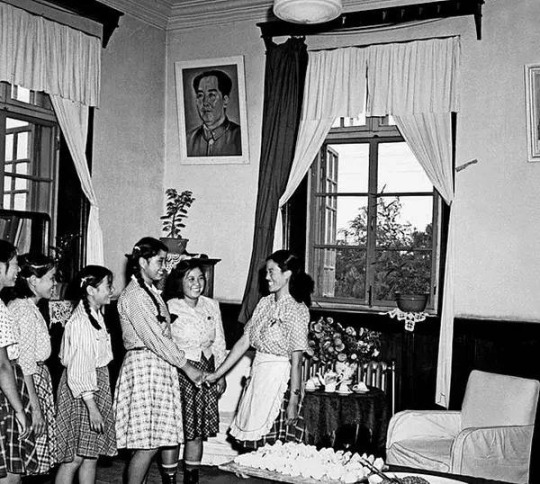
Source
Workers on a day off.
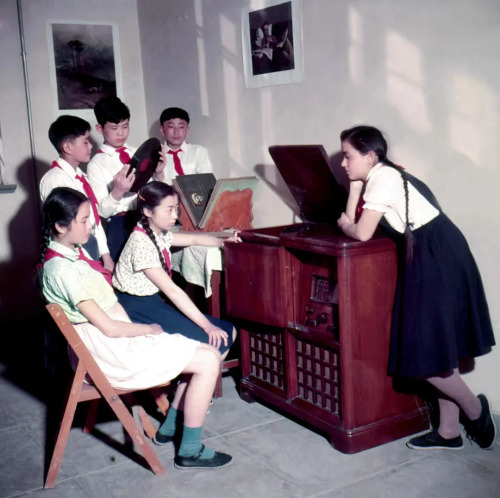
Source
Some 50s school children.
There are also photos from other Eastern Bloc countries to corroborate:

Source
Czech pioneer uniform, 1950.
There is this misconception that after the establishment of the PRC everyone just wore “plain and utilitarian clothes” therefore it is ok to use modern “plain and utilitarian clothes” for 1950s reconstruction. 1950s utilitarian clothes were, first and foremost, 1950s clothes, before they were utilitarian, and they used construction techniques and silhouettes very specific to that era. It’s kind of weird how I even have to point this out. Though now that I think about it, 1950s Chinese children’s blouses still occasionally used 1940s sewing techniques, like the gathered yokes and puffy sleeves.
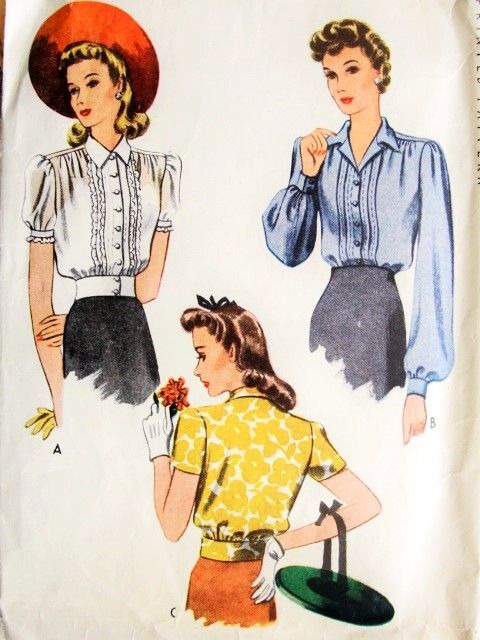
Source
40s blouses with gathered yokes and puffy sleeves, accentuating the flat and broad shoulders.

Source
50s blouses had more of a cap sleeved, smooth shoulder look.
The top featured in the video would make more sense as a 两用衫 liangyongshan (two purpose jacket) than a blouse, since two purpose jackets were usually untailored, hip length and have a turned collar. Though they would be made of thicker materials since they were outerwear and not blouses.

Source
1954 Artwork showing children in school. The teacher is wearing a two purpose jacket.
The other major problem with this interpretation of 1950s school uniforms is the misconception that red scarves were unique to the communist Pioneers or the PRC in general. Scarves or kerchiefs worn like that were not rare in everyday fashion of the early 20th century to begin with, and red scarves specifically were also commonly associated with militaristic or sporty youth groups at the time, particularly the girl scouts. I mean, the Pioneers were a militaristic adjacent youth group so it makes sense they would also use the red scarf.


This reference image is from the 1920s??? And they look like girl scouts uniforms not regular school uniforms?? Also even if that picture is from the 50s, her outfit looks nothing like it?? I’m so confused😵
All of the results that showed up in my reverse image search of the picture are very suspicious websites so I don’t want to click on them, though I’m pretty sure that is a photograph of two girl scouts from either the 1910s or 20s. This means that the red scarves the two girls are wearing in the photograph are a part of their girl scouts uniform and have nothing to do with the communist Pioneers, which this look is supposed to represent. The outdoorsy top with the drop waist and buttoned pockets, the straight cut and knee length skirt and the hat all point toward girl scouts uniform of previous decades.

Source
Girl scouts from Ohio, 1924.
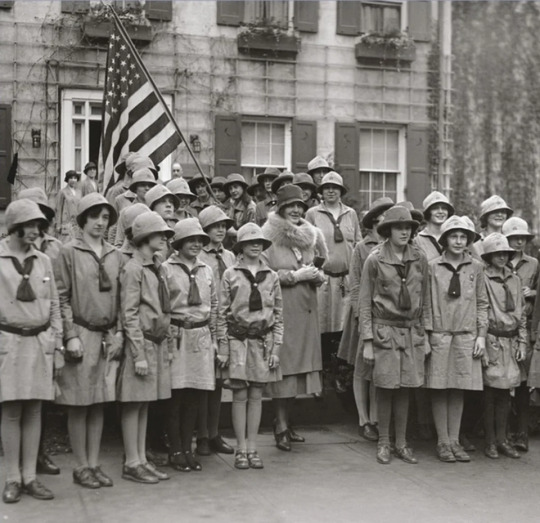
Source
Girl scouts of America (the photo is captioned ca. 1918 but the clothes look more late 20s to me).
I don’t think girl scouts were a thing in China after 1949 anymore, though if they still existed their uniforms would have a silhouette that’s closer to 1940s or 50s fashion, with a more tailored blouse with gathered yokes and puffy sleeves, and an A line skirt.

Source
Girl scout catalogue 1940.
1960s
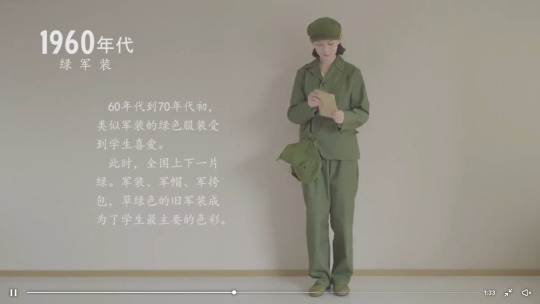
Ok so I’m a bit confused by the definition of “school uniform” here. All the previous looks were more or less for kids in school, but then this one jumps to university level. To my knowledge, I don’t think any children in school wore this uniform. The iconic red rectangular patches are also missing at the collar.
This is where my knowledge ends so I’ll stop here. Not gonna lie I lost a fair amount of braincells watching the video and reading the captions... I hope you enjoyed this post as that will make the sacrifice worth it. I thing I loved the most about this video was the background music, which made it sound quite comical and like a satirical video.
#republican era#vintage fashion#chinese fashion#1910s#1920s#1930s#1940s#1950s#1960s#cheongsam#mao era#costume analysis
659 notes
·
View notes
Text
🌼
A veces me emociono demasiado, sí, soy de esos que salen del cine después de haber visto Aladdín sintiendo que es la mejor película de la historia, pero miren, yo creo que este verso de la poeta y arquitecta china Lin Huiyin es probablemente la frase de amor más hermosa que se haya escrito jamás:
You are the April of this world.
6 notes
·
View notes
Photo

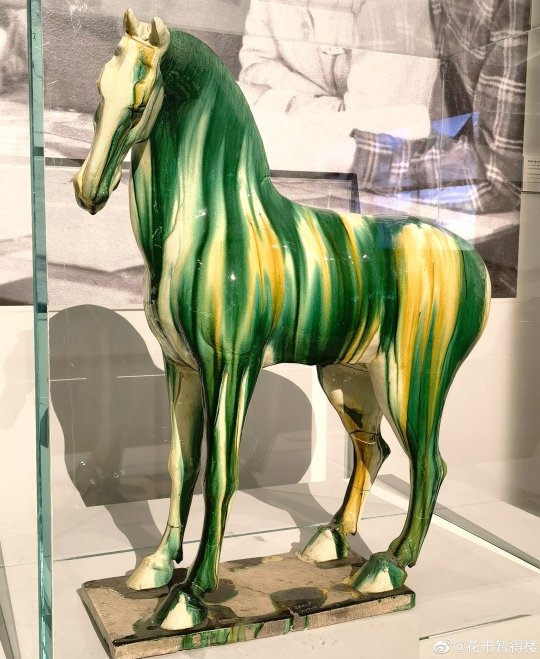
A stunningly glazed horse of the Tang dynasty (8th c AD), from the collection of Liang Sicheng & Lin Huiyin, a famed couple and pioneers of the history of Chinese art and architecture.
LOOK AT ALL THIS PERFECTION.
Source: https://twitter.com/xujnx
3 notes
·
View notes

